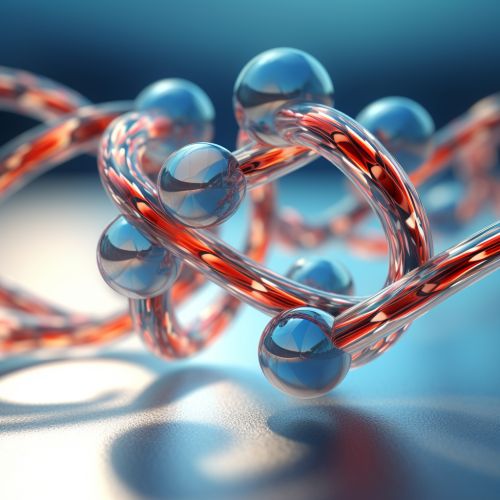Transfer RNA
Overview
Transfer RNA (tRNA) is a type of ribonucleic acid that plays a crucial role in the process of protein synthesis. It is responsible for transporting specific amino acids to the ribosome, where they are assembled into proteins based on the sequence of a messenger RNA (mRNA) molecule. Each tRNA molecule is specific to one amino acid, but can bind to several different sequences, or codons, in mRNA.


Structure
tRNA molecules are typically between 73 and 93 nucleotides in length. They have a complex three-dimensional structure, which includes several loops and a long, protruding arm. The structure of tRNA can be broken down into several key components:
- Acceptor Stem: This is a seven-base pair (bp) stem made by the base pairing of the 5'-terminal nucleotide with the 3'-terminal nucleotide. Its function is to hold the amino acid.
- Dihydrouridine (D) Arm: A four bp stem ending in a loop that often contains dihydrouridines.
- Anticodon Arm: A five bp stem ending in a loop that contains the anticodon.
- TΨC Arm: A five bp stem ending in a loop that often contains the modified nucleoside pseudouridine (Ψ).
- Variable Arm: This region varies in length and sequence and is located between the anticodon and TΨC arms.
Function
The primary function of tRNA is to deliver amino acids to the ribosome for incorporation into a growing peptide chain. To do this, each tRNA molecule must be charged with the correct amino acid. This process is carried out by a group of enzymes known as aminoacyl tRNA synthetases. Each of these enzymes recognizes a specific amino acid, as well as all the tRNAs that can be charged with that amino acid.
Once a tRNA molecule is charged, it can bind to the ribosome. The ribosome contains three sites for tRNA binding: the A (aminoacyl), P (peptidyl), and E (exit) sites. The mRNA molecule is read in the 5' to 3' direction, with each codon specifying a single amino acid. The tRNA molecules enter the A site of the ribosome, and if the anticodon of the tRNA matches the codon of the mRNA, the tRNA will bind to the mRNA. The amino acid is then added to the growing peptide chain, and the tRNA is moved to the P site and then to the E site before being released from the ribosome.
tRNA in Genetic Code
The genetic code is the set of rules by which information encoded in genetic material (DNA or mRNA sequences) is translated into proteins (amino acid sequences) by living cells. The code defines how sequences of nucleotide triplets, called codons, specify which amino acid will be added next during protein synthesis.
tRNA plays a crucial role in the genetic code as it is the molecule that actually "reads" the code in the mRNA. Each tRNA molecule has an anticodon that can base pair with one or more codons for an amino acid. Some tRNAs can recognize more than one codon due to a phenomenon known as wobble base pairing. This flexibility allows the cell to produce fewer tRNA species, while still being able to translate all 61 codons that specify an amino acid.
tRNA Modification
tRNA molecules undergo extensive post-transcriptional modification. Base modifications are particularly prominent in the tRNA's anticodon loop, where they are often required for correct codon recognition and to maintain the overall tRNA structure. Modifications to the tRNA can influence its stability, its ability to be aminoacylated, and its ability to interact with the ribosome and other proteins during translation.
tRNA in Disease
Mutations in tRNA genes, as well as defects in proteins involved in tRNA modification, can lead to disease. For example, mutations in mitochondrial tRNA genes are a common cause of mitochondrial diseases, a group of genetic disorders that affect the mitochondria, the energy-producing structures within cells. These diseases can affect any part of the body and can cause symptoms ranging from mild to severe.
